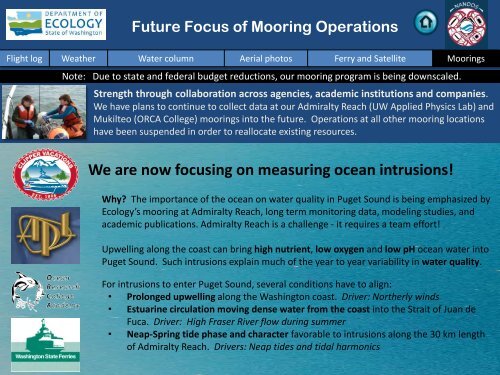Eyes Over Puget Sound
You also want an ePaper? Increase the reach of your titles
YUMPU automatically turns print PDFs into web optimized ePapers that Google loves.
Future Focus of Mooring Operations<br />
Flight log Weather Water column Aerial photos Ferry and Satellite Moorings<br />
Note: Due to state and federal budget reductions, our mooring program is being downscaled.<br />
Strength through collaboration across agencies, academic institutions and companies.<br />
We have plans to continue to collect data at our Admiralty Reach (UW Applied Physics Lab) and<br />
Mukilteo (ORCA College) moorings into the future. Operations at all other mooring locations<br />
have been suspended in order to reallocate existing resources.<br />
We are now focusing on measuring ocean intrusions!<br />
Why? The importance of the ocean on water quality in <strong>Puget</strong> <strong>Sound</strong> is being emphasized by<br />
Ecology’s mooring at Admiralty Reach, long term monitoring data, modeling studies, and<br />
academic publications. Admiralty Reach is a challenge - it requires a team effort!<br />
Upwelling along the coast can bring high nutrient, low oxygen and low pH ocean water into<br />
<strong>Puget</strong> <strong>Sound</strong>. Such intrusions explain much of the year to year variability in water quality.<br />
For intrusions to enter <strong>Puget</strong> <strong>Sound</strong>, several conditions have to align:<br />
• Prolonged upwelling along the Washington coast. Driver: Northerly winds<br />
• Estuarine circulation moving dense water from the coast into the Strait of Juan de<br />
Fuca. Driver: High Fraser River flow during summer<br />
• Neap-Spring tide phase and character favorable to intrusions along the 30 km length<br />
of Admiralty Reach. Drivers: Neap tides and tidal harmonics



